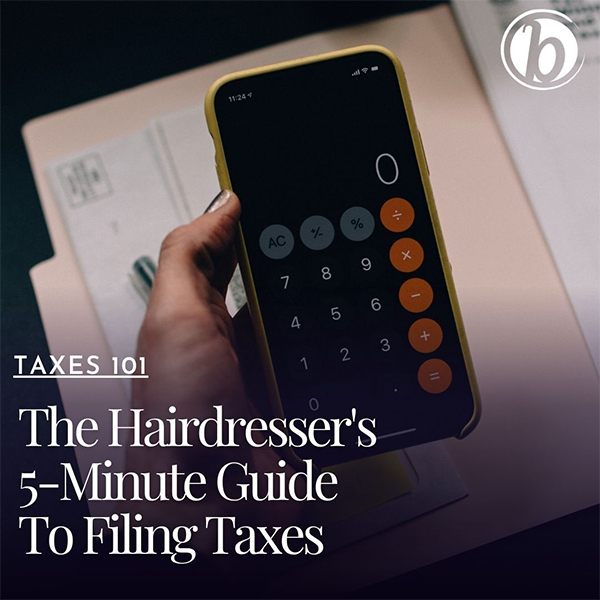5-Minute Tax Guide For Hairdressers
Hair Business 101: 5 Quick Tips To Make Tax Filing A Breeze
No matter your experience or role in the salon, we’re all in the same boat when it comes to tax season: Confusing forms, rapidly approaching deadlines and numbers that just aren’t adding up. (Talk about a headache!) To help make filing your taxes that much easier, we complied a list of must-know tips to get you through it. Trust us, you (and your wallet) will be thanking us later.
1. Identify your employment status on tax forms
Stylists have a wide range of options when it comes to employment status. Are you self-employed with a salon suite? Are you contracted, or are you a full-time employee at your neighborhood barbershop? Knowing your employment status is essential for correct filing, claiming credits and gaining certain business deductions that can help you in the long run.
Here’s how to tell each status apart:
- Self-employed: You’re likely a salon, suite or barbershop owner, unless the business is incorporated.
- Independent contractor: You set your own wages, pay a fixed monthly rent, set your own hours and pay for your own supplies. You also completed a W-9 and received a 1099-NEC during tax season.
- Employee: You completed a W-4 upon hiring and received a W-2 during tax season. You often have federal income tax, social security tax and medicare tax withheld from your paychecks.
Pro tip: Unlike employees, self-employed and contracted workers have to save up and pay federal income taxes and self-employment taxes themselves by making quarterly estimated tax payments using a 1040-ES.
2. Salon owners: Keep this list of common deductions close by.
Trying to lower your federal tax income burden? Hair salons often qualify for a long list of deductions that can help you do just that. If you’re not familiar with the term, deductions are qualifications that can reduce the amount of your income before you calculate the tax you owe.
Some common expenses you may be able to deduct include:
- Advertising such as online ads, signs and event sponsorships
- Retail or color products used or sold
- Insurance and retirement plans
- Salon supplies such as smocks, clippers and hot tools
- Rent for suite or salon owners
- Transportation to and from clients, as well as business trips away from your tax home
- Utilities like internet services, electricity and trash collection
- And more!
Pro tip: Stylists who work out of their own homes may even qualify for a “home office” deduction so long as the room they work out of isn’t used for personal purposes.
Unlock 103 potential tax write-offs for hairstylists with our FREE tax guide!
3. Remember to report your tip income.
Stylists are required to pay income tax, employee Social Security Tax and employee Medicare tax on their tips.
Self-employed & independent contractors: You should include any tips you personally receive in the income reported in your tax return.
Employee: Tip reporting is a shared responsibility with your salon owner. All you need to do is report your tips to your employer, who will then include it on your tax documents. If any tips go unreported, you’ll need to fill out Form 4137. This form includes unreported tips in your income and calculates any unpaid Social Security and Medicare tax that’s due.
New Venmo tax law: Here’s how new fees can affect your business
4. See if you qualify for education tax credits.
Continuing your education is good for more than just learning, after all. Stylists attending trade shows or professional training—similar to The BTC Show or BTC University—to further their careers may qualify for the Lifetime Learning Credit. This credit can be up to $2,000 per tax return to cover qualifying tuition and related expenses for you, your spouse or a dependent on your refund.
In order to qualify, you need to be enrolled at an eligible educational institution that participates in a student aid program run by the U.S. Department of Education. Hint: You’ll know if your institution qualifies if they send you a Form 1098-T for the tuition payments you made.
Pro tip: So, why go for a credit instead of trying to list education as a deduction? A tax credit is always preferable to a tax deduction because it lowers the tax you pay instead of your income.
Get more in-the-know business tips with unlimited courses on BTC-U!
5. Organize your expenses in advance.
Tax experts recommend that stylists and salon owners invest in some type of accounting software—like Quickbooks—to keep track of all yearly expenses. By tax season, you’ll have everything you need in one place. The result: Quicker, seamless filing.
Disclaimer: We are sharing this info to be helpful, but we are not certified CPAs or tax attorneys. Use this info to discuss and analyze your own tax situation with a professional tax preparer.








